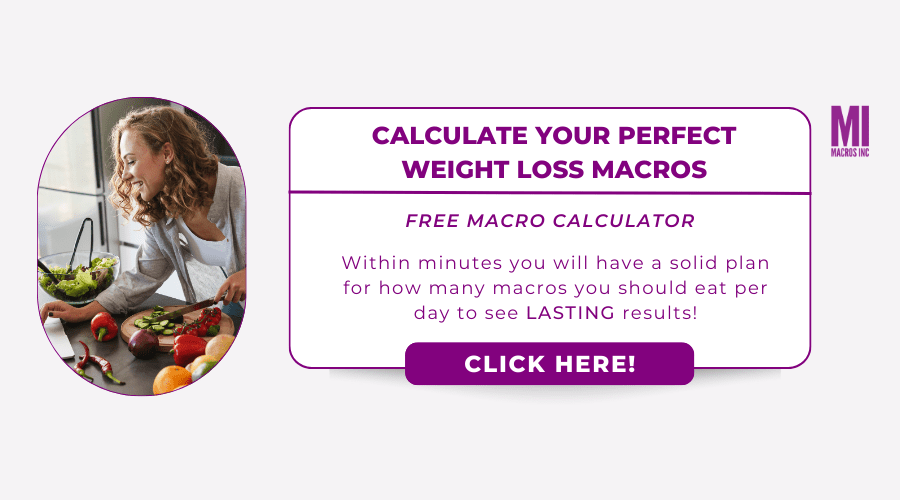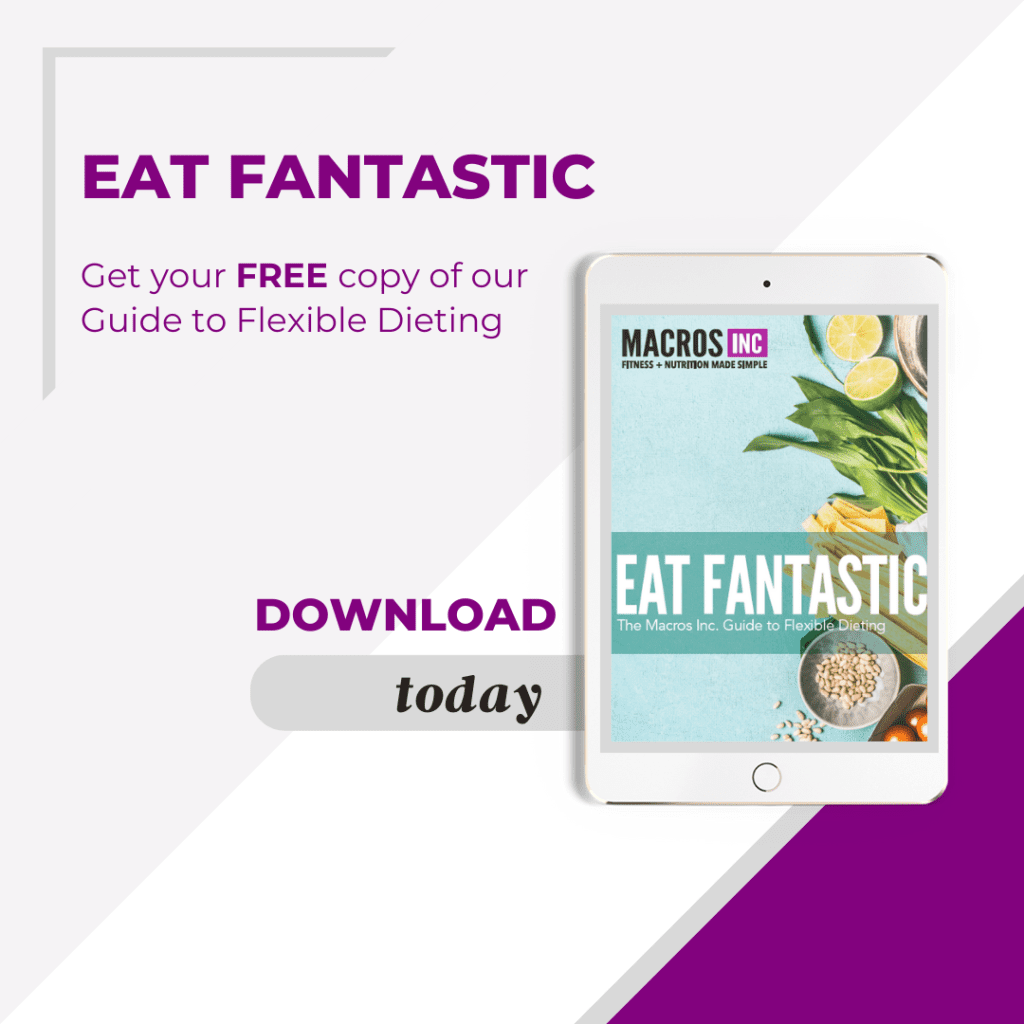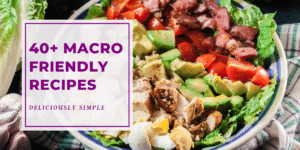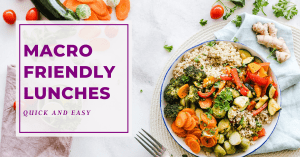How to Lose Weight the Healthy way
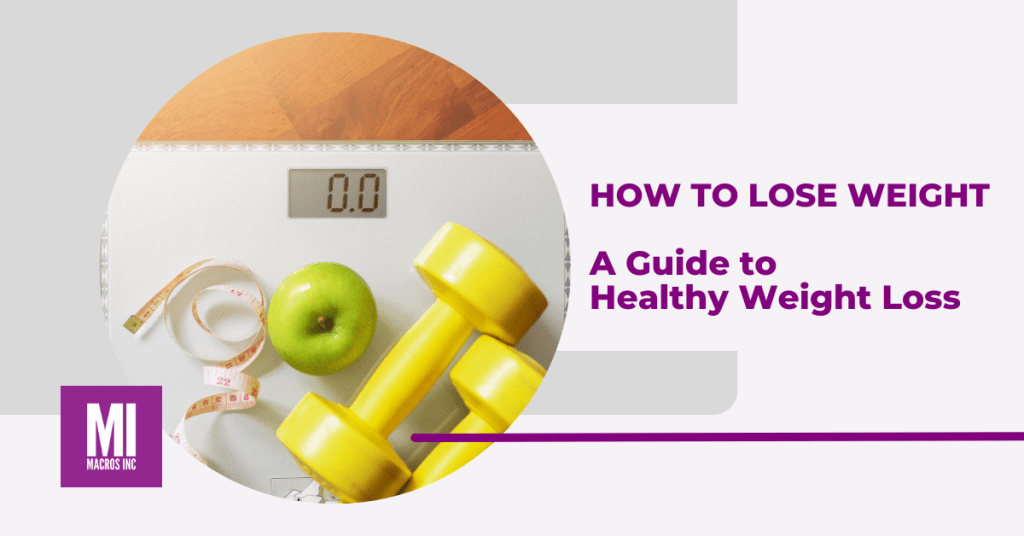
Welcome to the world of healthy eating for weight loss! In this guide, we’ll explore the simple mechanics of shedding pounds by creating an energy deficit. We’ll discuss various diets, emphasizing the importance of consistency and patience and discover the principles of a balanced, nourishing diet that promotes overall well-being.
We focus on making sustainable changes that fit into your lifestyle. It’s not about quick fixes or extreme measures; instead, we’ll encourage habits that promote lasting results. You’ll learn about the importance of balanced nutrition, including the role of unprocessed foods and plant-based options in supporting your weight loss goals.
So, dive in, embrace the knowledge, and start on your journey to learn how to lose weight the healthy way!
How Weight Loss Works
While weight loss is often thought of as a very complicated endeavor, the actual mechanism of weight loss is quite simple: your body must be in a state of calorie deficit to lose weight.
But what exactly does that mean? It means that your body has to burn more calories per day than you are consuming. This also means that there are really only two major “levers” that control whether you gain or lose weight:
- The calories you consume (the energy going into your body)
- The calories you expend (the energy leaving your body)
On the surface, this seems relatively simple, and in some ways it is. The energy going in part of the equation is relatively straightforward; it is just the amount of calories that you consume from your food. Most diets aim to help people consume less food (more on that below).
The calories-out part of the equation gets slightly more complicated, but in reality, we can break it into two major pieces: resting energy expenditure and non-resting energy expenditure.
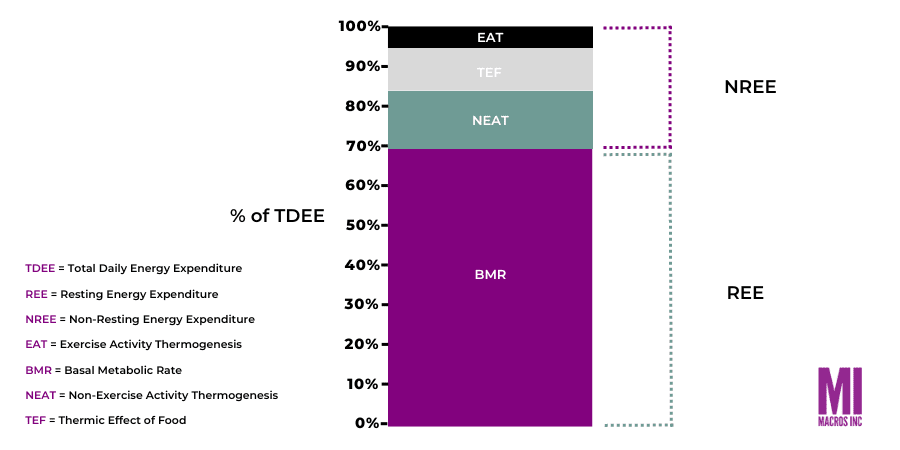
Energy Expenditure Explained
Resting energy expenditure (REE) is the energy it takes your body to function without doing any additional physical activity. This is the energy you spend to pump blood, think, breathe, create chemicals in your body, etc.
Non-resting energy expenditure (NREE) is the energy it takes your body to do everything else, which fundamentally boils down to three main things:
1) Digesting food, which we call the thermic effect of food (TEF
2) Physical activity of daily living that is non-exercise activity, which we call non-exercise activity thermogenesis (NEAT)
3) Physical activity that is structured exercise, which we call exercise activity thermogenesis (EAT).
Most people can affect their energy expenditure by increasing both their NEAT and the EAT. However, for many people the NEAT is far more important for weight loss and maintenance of weight loss than their EAT. This is due to the fact that NEAT accounts for a much larger portion of our calorie expenditure than our EAT does. Additionally, changes in NEAT are a much better predictor of weight loss than changes in EAT.
What Healthy Weight Loss Looks Like
Weight loss can be achieved through a lot of different approaches that manipulate calorie intake and calorie expenditure, which means that weight loss can vary substantially from person to person based on how they go about weight loss.
There are approaches that utilize very low calorie intakes (e.g. 800 calories a day) and approaches that utilize extreme physical activity to get much faster results. However, many times faster weight loss is not always better and is not always healthier. There are some good guidelines for what is often considered “healthy weight loss” in terms of the amount of weight individuals should aim to lose
What is a Healthy Rate of Weight Loss Per Week?
The most common recommendation for rate of weight loss is ~0.75-1.5 pounds per week, or 0.5% to 1% of weight loss per week. This recommendation is based mostly on the fact that weight loss of ~1 pound per week can be achieved with a ~500 calorie per day deficit, which is an achievable and sustainable number for most people.
Individuals who have more weight to lose (~50-300 pounds) can aim for weight loss greater than a pound per week during their initial stages of weight loss due to the fact they have more body weight and general higher resting metabolic rates which makes it easier to achieve higher deficits without overly aggressive calorie restriction.
Types of Diets Used for Weight Loss
There are dozens and dozens of diets that have been promoted as tools for weight loss. This includes diets like the Paleo Diet, the Keto Diet, Intermittent Fasting, Vegan Diets… the list goes on.
What is interesting is that all of these diets can work and they can lead to weight loss.
But how is that possible? If they are all so different, how can they all result in weight loss? Well, the answer is relatively simple: all these diets lead to people consuming fewer calories and ultimately being in a calorie deficit.
Each diet leads to a calorie restriction through slightly different ways; however, there are core principles about adopting any major diet that can help you understand how they work:
- Habit Change: Anytime you engage in a new diet, you are changing habits and environmental cues, which often leads to a reduction in calories.
- Food Restriction: Many diets lead to a restriction of one or more foods and/or food/nutrient groups, which often leads to a reduction in calories.
- Reduced Enjoyment: Many diets force people to adopt less enjoyable, more bland foods, which often results in less food and calorie intake.
- Hunger Management: Many diets promote higher satiety foods, including more fibrous veggies and protein, which often leads to a reduction in calories.
The Keto Diet
The Ketogenic Diet was originally invented in the first half of the 20th century as a potential treatment for epilepsy. It was brought into mainstream diet culture for weight loss toward the end of the 20th century and became incredibly popular as a weight loss tool between the years of 2010 and remains a popular weight loss tool to this day.
This diet promotes a very low carbohydrate intake (often <50 grams per day), a very high fat intake, and moderate protein intake. There are a lot of inaccurate claims about ketogenic diets, such as they are superior for weight loss to other diets when they are equal to other diets.
However it can be a tool for weight loss due to the following reasons:
- Adopting a ketogenic diet often is a large departure from normal eating behaviors, which leads to consuming fewer calories
- Ketogenic diets substantially reduce an entire macronutrient to very minimal levels, which leads to consuming fewer calories
- Ketogenic diets can make diets less palatable by limiting textures and nutrients, which leads to consuming fewer calories
- Ketogenic diets that promote higher protein intake can increase satiety, which leads to consuming fewer calories
There are some pitfalls to ketogenic diets people should keep in mind. The first is the restrictive nature of the diet, which adds an extra layer of difficulty for adherence. The second is that meeting fiber requirements and eating enough fruits and vegetables can be difficult. Third, people must be mindful of the types of fat they are consuming as some fats can have deleterious effects on cardiovascular risk markers, especially if the diet does not result in weight loss.
Intermittent Fasting
Fasting has been used in cultures for thousands of years and has been used as a way to lose weight for at least the last century. However, more recently more structured approaches to fasting have been developed and utilized to help fit in with modern life.
Intermittent fasting approaches can vary from just shortening the feeding window to eight hours a day (18:6 fasting) or to completely skipping days and eating every other day (Alternate Day Fasting).
This approach can be an effective tool to lose weight, but the last decade of research on the topic has shown that it is not superior to other forms of calorie restriction for weight loss or other metabolic benefits.
Intermittent fasting can help people lose weight for the following reasons:
- Reducing from 3 meals a day to 1 meal a day is a substantial departure from normal eating behaviors, which can lead to fewer calories being consumed.
- Learning to go long periods without eating can help manage hunger much better, which can lead to fewer calories being consumed.
The Macros Diet
The “Macros Diet” is believed to have been designed in the late 1980s or early 1990s when the science around weight loss was really being developed and the concept of energy balance took shape. As nutrition science progressed and the understanding of how many calories existed in each of the macronutrients and the guidelines were established for how many of each macronutrient the body needs, people began to look at the “math” side of dieting and put parameters around energy and nutrients.
Eventually, the concept of a “Macros Diet” extended beyond it being a diet and it being used more as a tool and a method of “accounting for energy” than it actually being a “diet”. This is because the concepts and tools surrounding a macros approach to dieting is relatively “diet agnostic” and is really a method of understanding what you are eating and how it affects your body.
Realistically, all diets rely on the concepts of a Macros Diet. Every single one. They just often don’t report the math behind it. For example, a ketogenic diet can utilize the tools of a Macros Diet by tracking calories, fats, carbs, and protein, and increase the likelihood of being successful. The same applies to vegan diets, Paleo diets, and intermittent fasting based diets.
Utilizing a Macros based approach to weight loss is one of the best ways to not only lose weight, but to also build lifelong skills. This is due to the fact that through following a Macros-based diet you develop a very deep understanding of the energy content and the nutrition that is present in the food you consume. You also build habits that you can draw on at any time and in any situation to help you problem solve weight loss or weight gain problems in the future.
Flexible Dieting
The concept of flexible dieting has been used interchangeably for years, but they are different concepts. The idea of flexible dieting boils down to the idea that there are not any “off limit” foods when trying to lose weight because it all comes down to a calorie deficit. This concept was originally popularized by the If It Fits Your Macros movement in the late 1990s through early 2010s.
Some of the most famous examples showing that there is a lot of flexibility in food choices as it relates to weight loss are the infamous “Twinkie Diet” experiment and the “Ice Cream Diet” experiment. While these are obviously not recommended approaches to weight loss, they are extreme examples highlighting the underlying principle of weight loss: a calorie deficit.
In a more reasonable approach, Flexible Dieting, can be thought of as a mindset one can apply to their overall diet. Meaning that people can follow a structured diet to help them establish habits and hit calorie and macro targets, but they can also add in foods that may be deemed less than ideal for weight loss.
Need some expert support and accountability to achieve healthy weight loss? Try our personalized coaching for FREE!
Get a dedicated nutrition coach free for 14 days. Simply fill in your details below and we’ll be in touch!
What are the Principles of a “Healthy” Weight Loss Diet
While weight loss is one thing, many people are also interested in improving their health through their diet. But what does it mean to “eat healthy” while losing weight?
The most simple way to think about this is that “eating healthy” means that you consume foods that lower risk of disease and actively promote health.
These are the following dietary principles that scientifically support the concept of eating healthy.
1) Manage calories
This is by far the number one step in “eating healthy”. Being in a state of calorie surplus adds extra metabolic risk and increases most of the risk factors for heart disease (some nuances here for lean people trying to “bulk” so let’s leave that as a separate case).
If you are eating 500-1000 calories a day more than you need and in a state of calorie balance, the minute effects of eating perfect foods really gets negated.
Start with understanding and managing energy needs.
2) Prioritize unprocessed foods
Processed foods are not horrible per se and you don’t have to eliminate them, but there are certain things about them that make minimizing them as part of the primary dietary pattern a smart idea.
Here are those things:
They generally tend to have higher energy density.
They tend to be more palatable, leading to greater calorie intake.
They tend to be lower in nutrient density.
They tend to be way more convenient.
They are often consumed in more of a “snacking” setting than a true eating setting.
They often have very few health promoting nutrients.
3) Make plant foods a part of your diet
Almost all observational studies show an inverse relationship between fruit/vegetable intake and chronic diseases. Look… you do not have to become a vegetarian but probably eat a few plants a day if you can. They have fiber, vitamins, minerals and phytonutrients. You should probably eat some fruit and veggies and some starch.
4) Keep the alcohol intake as moderate as possible
Sorry… that’s just what the data tells us. The more you reduce alcohol intake the better your health outcomes are… in general.
Lowering alcohol intake generally lowers calories, improves blood lipids, and lowers risk of most diseases. Going from 5 drinks a week to 1 makes WAY more difference than going from 1 to 0.
You don’t have to eliminate it… just keep it to a minimal level of “health” is your goal.
5) Processed meats probably are a good idea to skip more often than not
Of all the observational research in nutrition science, this finding is pretty consistent. Processed meats generally tend to increase risk of disease and lowering their intake lowers risk of disease.
Whether this is directly due to their intake or if it’s a proxy for other habits is a good question… but… pepperoni probably doesn’t need to be a staple.
healthy recipes to help you lose weight
Eating healthily doesn’t have to mean boring and bland. We’ve built a range of delicious and nutritious recipes in our free macro-friendly cookbook, to help you make some smarter choices throughout the day on your weight loss journey.
You can also find a selection of our recipes in our blog below and in the recipes section of our site!
Our Top 10 Tips To Healthy Weight Loss
In addition to understanding your personal energy needs, tracking calories and macros, and establishing a sustainable calorie deficit, there are some habits and approaches that you can adopt that can help you achieve your weight loss goals.
1. Increase your NEAT
Walking, doing chores around the house, physical labor, and other forms of non-exercise movement are incredibly important for weight loss. In fact, NEAT is one of the biggest predictors for weight loss or weight gain. Making NEAT a priority in your life by walking more is perhaps the most effective piece of advice for weight loss.
2. Prioritize Protein
As a society we may have gotten a bit crazy on protein intake (anything more than ~0.7-1.0 grams per pound of body weight is not necessary), prioritizing protein intake is a highly effective tool to help people lower total calorie intake and keep you feeling fuller, longer.
3. Change Your Environment
Putting the foods you want to consume in your house and removing the foods you don’t want to consume can increase your likelihood of making good food decisions on a consistent basis. While we can still Door Dash food, having the food we want to consume in the house makes us more likely to choose that food.
4. Don’t Eat Mindlessly
Taking time to sit down and focus on what you are eating can reduce the likelihood of mindlessly consuming calories. If you want a snack, don’t eat out of the bag while standing in the kitchen. Instead pour a serving into a bowl or a plate and take the plate to the table or your desk and eat it away from the source.
5. Don’t Overly Restrict
When weight loss is the goal, you will have to restrict your life in some ways, but you don’t need to over restrict yourself. Allow yourself to eat foods you enjoy, but limit the quantity and how often you eat them.
6. Lift Weights
Lifting weights while trying to lose weight can help you maintain your muscle mass and increase the percentage of weight loss that comes from body fat as compared to your hard earned muscles.
7. Get Sleep
Poor sleep is a surefire way to ensure that you make less than ideal food choices the following day.
8. Be Honest With Yourself
As humans we are often really bad at self-assessment. This is especially true when it comes to our food intake and our physical activity. In fact, people often underestimate their own calorie intake by almost 50%. We also overestimate our physical activity by up to that much as well.
9. Stay Hydrated
Hydration status can affect our perception of hunger and our desire for food. Staying hydrated can be one tool to help people ensure better manage hunger during the day.
10. Be Patient
Weight loss is a journey and is often a longer process than people think. Most people gain weight over periods of years or decades and assume that 3-4 months is all it will take to undo years of weight gain. However, it often takes longer than people initially think to reach their targets, so patience is incredibly important.
Weight loss plateaus
No weight loss journey is perfect or linear. There are ups and downs and periods where weight loss seems to have completely stalled. We often get incredibly frustrated by these and start to think something is wrong with us. However, weight loss plateaus are 100% normal and expected.
Here is what you need to know about weight loss plateaus and how you can get out of one (if you are actually in one).
- Make sure you are actually in a plateau: It is important to understand if you are actually in a plateau or if you are just experiencing some body weight fluctuations that are masking fat loss that are masking fat loss. Your body can be increasing and decreasing daily in weight due to changes in body water and/or nutritional status (fed vs fasted) than can mask fat loss. The best way to tell if you are actually in a plateau is to weigh yourself daily and then look at your weekly average body weight over a 4-6 week period. If that number is staying the same, then you are probably actually in a plateau.
- Check-In With Yourself: Once you determine that you are actually in a plateau, the next thing to do is the do an honest checkin with yourself about your habits, your calorie intake, and your level of physical activity. It may be that you are underestimating your food intake or overestimating your physical activity or both. Or maybe you have had too many weekends of being off your plan that is offsetting the work you are doing during the week. Take an honest accounting of your habits and behaviors and see if something needs to change.
- Your Body May Be at a New Equilibrium: One of the things that happens during weight loss is that your body fundamentally changes. What your body needed 50 pounds ago is not what your body needs now. For example, if you started at 250 pounds and you were consuming ~2300 calories a day and walking a mile a day and losing weight but now you are 200 pounds, your body has way less mass (50 pounds less) so your total energy needs are lower and that mile walk is burning less calories than it did before because you are moving less body mass around. You may need to update your plan to accommodate for all the progress you have made.
- Take a Diet Break: There is some evidence that during long weight loss journeys (6 months or more), taking short periods where you eat at maintenance for a week or two can be very effective for preventing or getting out of a plateau. This is most likely due to the fact that it gives people a mental break and lets them “reset” their ability to adhere to a calorie deficit, but it may also have some beneficial effects on your metabolism by preventing dieting induced drops in NEAT.
Things to avoid when trying to lose weight
The journey to weight loss can often feel overwhelming. This is due to the amount of work that it seems like it is going to take and how many distractions there are and how much conflicting information there is about what works.
Here are some of the distractions and false information that you can avoid to help you have a smoother, more productive journey.
- There are no diets that magically work better than others: No seriously. Tens of thousands of dieting studies have been conducted and none of them (yes, even the most recent amazing book you read) have magical weight loss powers. Not fasting, not keto, nothing. It’s sad… but it’s true.
- Over-the-counter weight loss supplements DO NOT work: There are a few FDA approved weight loss medications that work by either increasing metabolic rate or lowering appetite (Or both). Those medications have meaningful efficacy but also have side effects and are utilized under closer physician supervision. There are no really effective over-the-counter weight loss supplements that are worth the money. There are some things that can convey a very, very small benefit (like caffeine, green-tea extract, and a few others), but most studies show they provide maybe a pound extra of weight loss over a 12-month period.
- The fastest way to weight loss is consistency: Jumping from diet to diet and exercise program to exercise program just resets the clock on establishing long-term habits that lead to sustainable weight loss. The fastest way to get to your end goal is to be consistent. “Slow is smooth, smooth is fast”.
In Summary
Remember, healthy weight loss is not about finding a magical diet or taking shortcuts with over-the-counter supplements. The key to successful and sustainable weight loss lies in understanding and managing your energy needs, making wise food choices, and being consistent with your habits.
By prioritizing unprocessed foods, incorporating plant-based options, and staying mindful of your calorie intake, you can improve your health while shedding pounds. Remember to stay patient, as weight loss takes time and effort. Focus on increasing your non-exercise activity and getting enough sleep, as these factors can significantly impact your progress.
Avoid getting discouraged by occasional plateaus, as they are normal during weight loss journeys. Evaluate your habits honestly, consider taking a diet break if needed, and adjust your approach to suit your body’s changing needs.
When seeking guidance, avoid falling for fad diets and expensive supplements promising quick results. Instead, seek consistency in your dietary and exercise habits, and consider working with a knowledgeable coach who can offer personalized support.
Remember, healthy weight loss is not about drastic measures, but rather sustainable changes that promote overall well-being and a balanced lifestyle. Stay focused, stay consistent, and embrace the journey to a healthier you.

